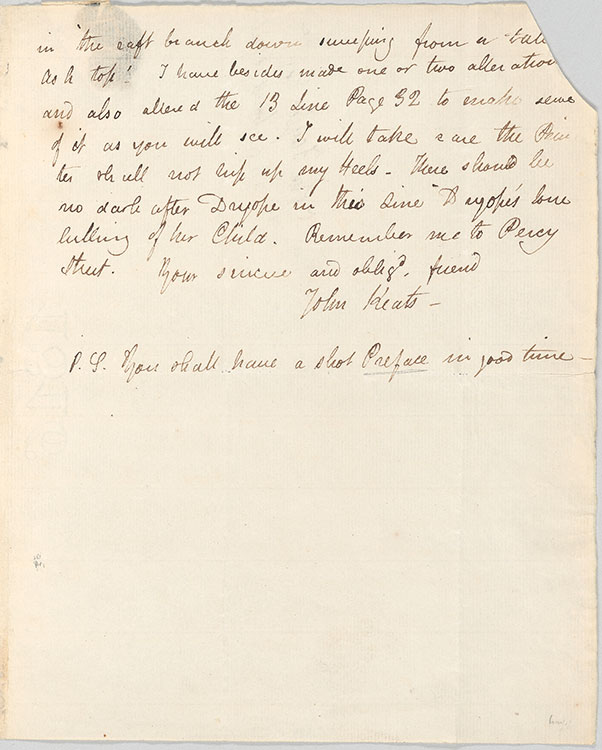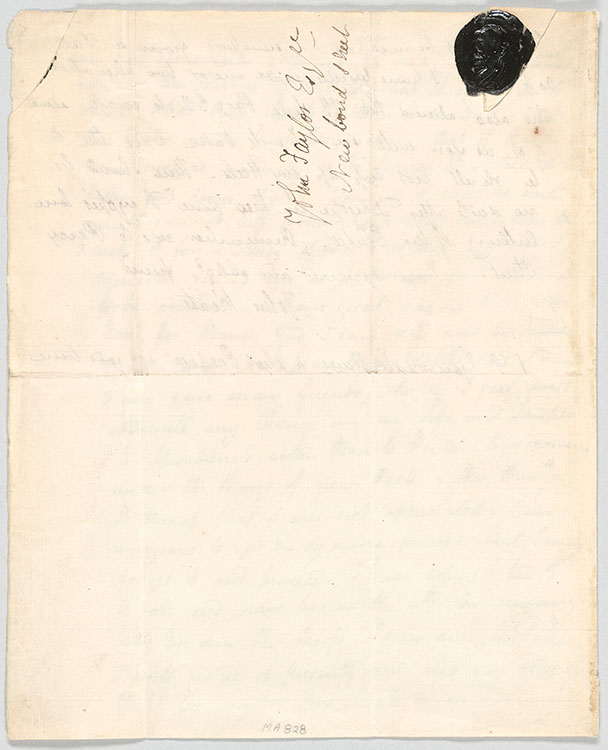An Early Keats Purchase by Greene
 The origin of Belle Greene’s interest in John Keats is obscure. Though we know she enjoyed reading poetry—especially Shelley, Keats, Dante, and Baudelaire—it is unclear whether her taste in literature was cultivated in childhood by her father, the educator and activist Richard T. Greener (1844–1922), or later in life. Extant archives offer tantalizing glimpses of Greene’s interest in Keats, though many questions remain: what were her favorite Keats poems, for instance?
The origin of Belle Greene’s interest in John Keats is obscure. Though we know she enjoyed reading poetry—especially Shelley, Keats, Dante, and Baudelaire—it is unclear whether her taste in literature was cultivated in childhood by her father, the educator and activist Richard T. Greener (1844–1922), or later in life. Extant archives offer tantalizing glimpses of Greene’s interest in Keats, though many questions remain: what were her favorite Keats poems, for instance?
By 1909, a few years after starting her position as J. Pierpont Morgan’s Librarian, Greene was actively purchasing Keats manuscripts for the collection. Her first documented acquisition of a Keats manuscript is a lengthy journal-letter sent by Keats in September 1819 to his brother George and sister-in-law Georgiana, both of whom had been living in America since the summer of 1818. Keats customarily sent them long, descriptive letters like this one, composed over the course of ten days; these letters touched upon his life and work and sometimes included copies of his poetry. Greene acquired the letter at the 1909 auction of Louis J. Haber’s British literature collection, with the bookselling firm George H. Richmond acting as her agent. A.J. Bowden, an employee at the firm, described the twenty-eight page manuscript as “the best thing of its kind ever offered.”
Belle Greene’s most important early Keats acquisition came in 1912, when she procured a letter written by Keats in February 1818 to his publisher John Taylor (1781–1864). Frank Wheeler of J. Pearson & Co., the same dealer who sold the Endymion manuscript, offered the letter to Greene, as described in a letter to J. Pierpont Morgan:
“Last month I sent Miss Greene an advance copy of a printed (and priced) list of Books and Manuscripts of superlative importance which I had been lucky enough to purchase privately … Miss Greene has made her selection— inter alia, a superb letter of Keats about the publication of Endymion— the finest Poet’s letter that I’ve ever seen.”
The acquisition shows Greene’s discerning eye for collection development, as the letter, sent to Keats’s publisher John Taylor, contextualizes the publication of Endymion in interesting ways. Keats responds to editorial queries about punctuation and proof corrections while also commenting more generally on the role of the poem in his fledgling career. As Keats writes, using a rather obscure metaphor, “In Endymion I have most likely but moved into the Go-cart from the leading strings.” (A “go-cart” is a walker for babies and would have marked a progression from “leading strings,” also used to aid small children learning to walk.)
Most notably, the letter outlines Keats’s three “Axioms” for poetry:
1st I think Poetry should surprise by a fine excess and not by Singularity— it should strike the Reader as a wording of his own highest thoughts, and appear almost a Remembrance—
2nd Its touches of Beauty should never be half way thereby making the reader breathless instead of content: the use, the progress, the setting of imagery should like the sun come natural [,] natural too [sic] him—shine over him and set soberly although in magnificence leaving him in the luxury of twilight. but it is easier to think what Poetry should be than to write it —
[3rd] and this leads me on to another axiom. That if Poetry comes not as naturally as the Leaves to a tree it had better not come at all.
This famous commentary on poetics exists in the absence of any formal work by Keats on literary theory or criticism: unlike Coleridge, with his Biographia Literaria (1817), or Wordsworth, with his “Preface” to Lyrical Ballads (1800), Keats did not publish works of literary criticism but rather expressed such ideas in private letters.
The first of the axioms, from which this exhibition takes its title, speaks to the authenticity of imaginative expression, which seems to approximate a reader’s own thoughts and resemble a deeply held memory. The notion of poetry “surpris [ing] by a fine excess” complements the second axiom’s focus on how a writer should deploy imagery and “its touches of Beauty.” The third and final axiom is certainly the most famous, though Keats undercuts its impact by admitting, at the end of axiom two, that “it is easier to think what Poetry should be than to write it.”
Baron Adolf De Meyer, Belle Greene [photograph], ca. 1910? ARC 1664. Archives of the Morgan Library & Museum
Frank Wheeler letter to J. Pierpont Morgan, p.1

Frank Wheeler, letter to J. Pierpont Morgan, 12 May 1912, p. 1. ARC 1310. Archives of the Morgan Library & Museum.
p. 1
Aus 22/5/12
Call one morn[in]g 10:30
6 copies Prayer Book Dictionary to Miss Greene
May 21st 1912
J.P. Morgan Esqr
My dear Sir,
I see by “the Times” that you have arrived
in England.
Last month I sent Miss Greene an
advance copy of a printed (and priced)
list of Books and Manuscripts of
superlative importance which I had
been lucky enough to purchase privately.
Everyone was a picked copy and had
passed through my hands at the
commencement of “the eighties” before
prices had commenced to soar upwards.
Now, after 30 years, I’ve re-purchased
them.
Miss Greene has made her selection—
inter alia, a superb letter of Keats about
Frank Wheeler letter to J. Pierpont Morgan, p.2

Frank Wheeler, letter to J. Pierpont Morgan, 12 May 1912, p. 1. ARC 1310. Archives of the Morgan Library & Museum.
p. 2
the publication of Endymion—the finest
Poet’s letter that I’ve ever seen.
I’m sending you herewith a copy
of this special Catalogue which I
believe to be the best ever issued by any
bookseller but I’m not issuing it to the
public till you have been to see me
I’m also sending you the “Prayer
Book Dictionary”, just published, as
well as a photograph of the magnificent
Bible presented to Charles II when he
landed at Dover on his return from
exile.
This Bible is reserved for you.
Yours very obli[gingly?]
F. Wheeler
John Keats letter to John Taylor, p. 1

John Keats, letter to John Taylor, 27 February 1818, p. 1. MA 828. Purchased by Belle da Costa Greene on behalf of J. Pierpont Morgan, 1912.
p. 1
Hampstead 27 Feb[ruar]y
London L 1818
My dear Taylor,
Your alteration strikes me as being a great
improvement. the page looks much better. And now I will
attend to the Punctuations you speak of — the comma
should be at soberly, and in the other passage the comma
should follow quiet,. I am extremely indebted to you
for this attention and also for your after admonitions.
It is a sorry thing for me that any one should have
to overcome Prejudices in reading my Verses. that affects
me more than any hypercriticism on any particular
Passage. In Endymion I have most likely but
moved into the Go-cart from the leading strings.
In Poetry I have a few Axioms, and you will see
how far I am from their Centre. 1st I think Poetry should
surprise by a fine excess and not by Singularity —
it should strike the Reader as a wording of his own highest
thoughts, and appear almost a Remembrance —
2nd Its touches of Beauty should never be half way
thereby making the reader breathless instead of content:
the use, the progress, the setting of imagery should like
the sun come natural[,] natural too [sic] him—shine over
John Keats letter to John Taylor, p. 2

John Keats, letter to John Taylor, 27 February 1818, p. 2. MA 828. Purchased by Belle da Costa Greene on behalf of J. Pierpont Morgan, 1912.
p. 2
him and set soberly although in magnificence leaving
him in the luxury of twilight. but it is easier to
think what Poetry should be than to write it — and
this leads me on to another axiom. That if Poetry
comes not as naturally as the Leaves to a tree it had
better not come at all. However it may be with
me I cannot help looking into new countries
with ‘O for a Muse of fire to ascend!’— If Endymion
serves me as a Pioneer perhaps I ought
to be content: I have great reason to be content,
for thank God I can read and perhaps
understand Shakspeare to his depths, and I have
I am sure many friends, who, if I fail, will
attribute any change in my life and Temper
to Humbleness rather than to Pride — to a cowering
under the Wings of great Poets rather than to a
Bitterness that I am not appreciated. I am
anxious to get Endymion printed that I may
forget it and proceed. I have coppied [sic] the 3rd
Book and have begun the 4th. On running
my Eye over the Proofs, I saw one Mistake
I will notice it presently and also any others if
there by any. There should be no comma
John Keats letter to John Taylor, p. 3

John Keats, letter to John Taylor, 27 February 1818, p. 3. MA 828. Purchased by Belle da Costa Greene on behalf of J. Pierpont Morgan, 1912.
John Keats, letter to John Taylor, 27 February 1818, [blank]. MA 828. Purchased by Belle da Costa Greene on behalf of J. Pierpont Morgan, 1912.
p. 3
in ‘the raft branch down sweeping from a tall
ash top’ I have besides made one or two alterations
and also altered the 13 Line Page 32 to make sense
of it as you will see. I will take care the Printer
shall not trip up my Heels. There should be
no dash after Dryope in this Line ‘Dryope’s lone
lulling of her Child. Remember me to Percy
Street.
Your sincere and oblig[e]d friend
John Keats
P.S. You shall have a short Preface in good time
